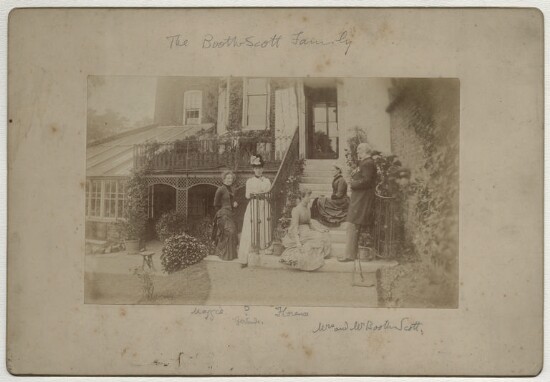Lieutenant William Booth Scott VR was the son of Mr John Scott, at one time editor of The Morning Advertiser. He was born in London on the 18 August 1822. He was very much the Victorian Engineer, working on many large civic improvements especially in St Pancras, a Freemason and member of the Victoria Rifles.
He was articled around 1838 to Mr E Jones, an architect and surveyor, whom he assisted in making extensive surveys in Surrey and in the Isle of Sheppy. On the expiration of his articles he was employed by Isambard Kingdom Brunel as an Assistant Engineer, first at the Ipswich Docks for about eighteen months, and subsequently on the Wilts and Somerset Railway.
He entered the Department of the Metropolitan Commissioners of Sewers, and rendered valuable assistance in the preparation of the great scheme for the drainage of London originally designed by Frank Foster. The laborious studies and calculations for that scheme were made at the Hatton Garden offices of the Metropolitan Commissioners of Sewers where he worked.
This department was absorbed into the newly created Metropolitan Board of Works to which Scott was appointed in 1856 as Chief Surveyor to the Vestry of St Pancras, which post he held until his death.
He was identified with every great work of improvement in the parish of St Pancras during the last five-and-thirty years of his life. His many works included the Battle Bridge Road, opened to the public in 1873, the Gloucester Gate Bridge over the Regent’s Canal, regarded as one of the finest bridges in London and built in 1877, and the bridge in Chalk Farm Road, also over the Regent’s Canal. The latter, although little appreciated by the general public, was considered by Mr Scott as one of his chief works, owing to the engineering difficulties which had to be overcome. He was also involved in a great many unglamorous projects of road building and widening and civic improvements needed in the burgeoning Imperial Victorian Capital.
He took great interest in securing open spaces for the parish. Under his supervision the old burial grounds of St Pancras, St Giles, St James (Westminster), St George (Bloomsbury), St George the Martyr, and St Andrew (Holborn), were laid out as recreation grounds and at the public opening of the extension of St. Pancras Gardens his services were warmly acknowledged.
The Institute of Civil Engineers, to which he was elected an Associate of the Institution on 4 December,1855, and transferred to the class of Member on 21 January 1862 records his manner and style:
“Mr Scott was a warm defender of what is sometimes called “red-tapeism.” In a most valuable report, prepared by him in 1890, on the works executed and improvements effected in the parish since 1856, he states that he had risked and incurred anger and ridicule for firmly and consistently upholding and abiding by stringent regulations which had conduced to the successful conduct of public business for so many years. “Strict attention” he says, to such rules is sometimes referred to, or often sneered at, as “red-tapeism,’ but it maybe unquestionably regarded as preferable to a loose and easier mode of conducting business, a mode which might open the door to genial carelessness insensibly degenerating into peculation.”
A copy of the report may be found in the library of the Institution of Civil Engineers.
Scott died suddenly of heart disease on the 31 of October 1891. On the previous day he was at his post for several hours, closely occupied in parochial business. For some time, however, his health had not been good; indeed, a year before his death he had warning of the condition of his heart. He appeared, however, to have benefited by a short stay in the country, and there was no reason for thinking his end so near.
He is shown above in a rare photograph held by the National Portrait Gallery with his family at their home at 16 Church Row, Hampstead, very much the Victorian gentleman and engineer.
Scott’s son Edwin Claude Porter followed his father into the Regiment and the Lodge. He also succeeded his father as Treasurer in 1888
Scott Senior was a member of two extremely old and distinguished Lodges – Albion Lodge No 9 and the ‘Red Apron’ Old Kings Arms Lodge No 28 (although at the time of his membership it was No 30). He became the fourth Worshipful Master of the Lodge in 1864, also becoming Treasurer, a post he held until 1888. He resigned due to ill health and was made an Honorary Member. He was the last surviving Founder, and died in 1891.
